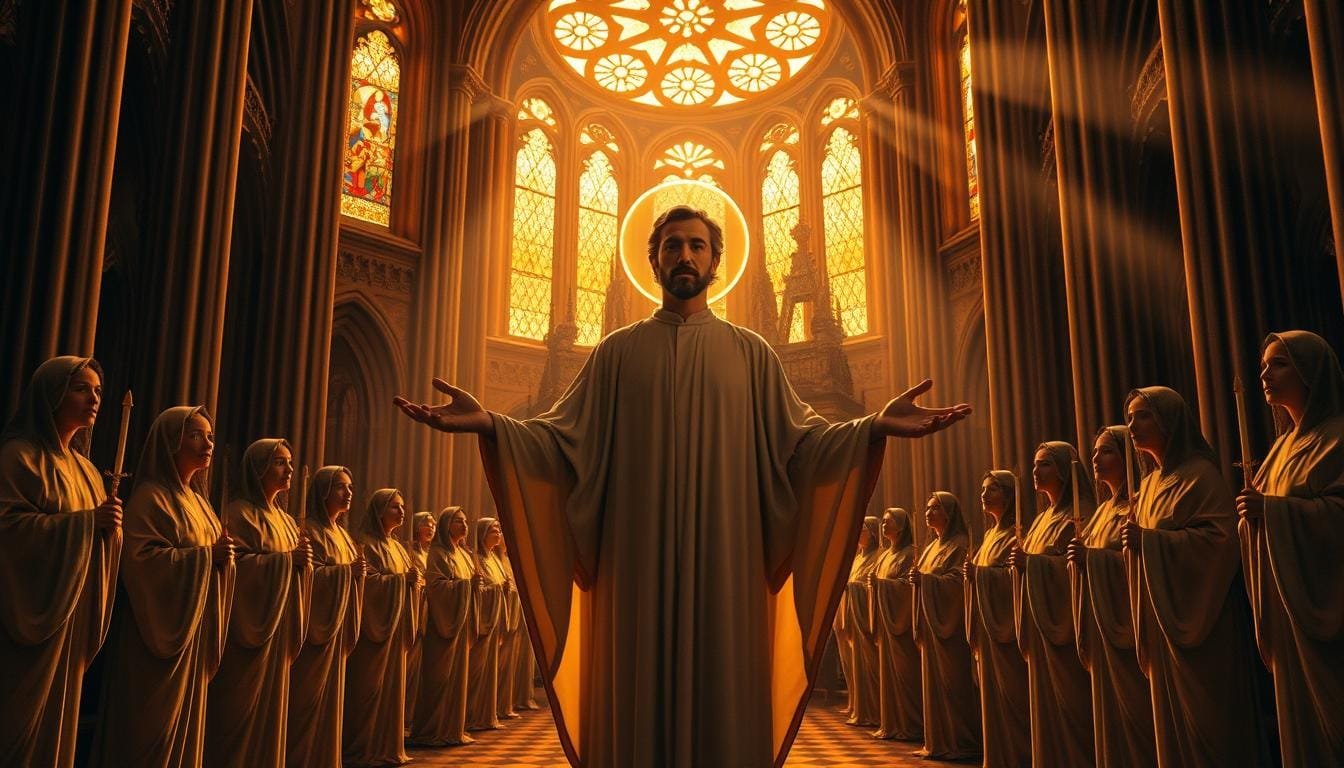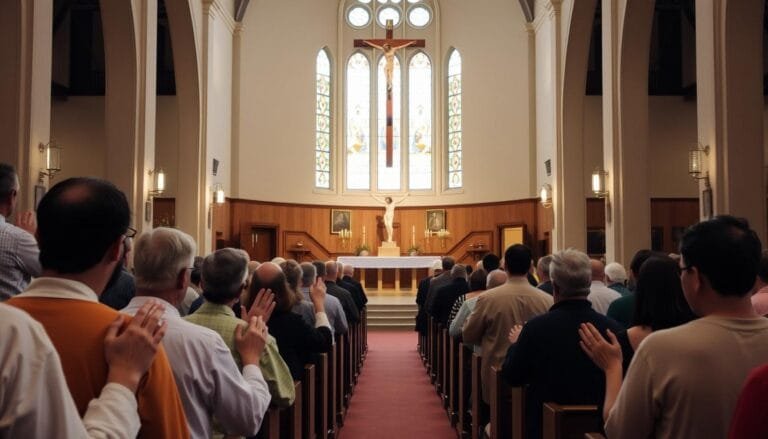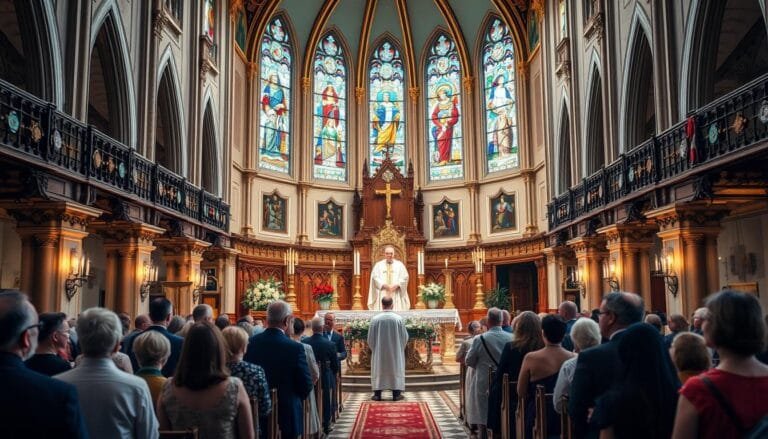Communion of Saints: Joining the Company of Saints in Faith
This website contains affiliate links. As an Amazon Associate, I earn from qualifying purchases. The content on this website was created with the help of AI.
As members of the Catholic Church, we believe in the Communion of Saints. This spiritual union connects us with saints and the faithful who have gone before us.
It’s based on the biblical idea of the Body of Christ, where all members are connected and interdependent.
The Communion of Saints is a key concept in Catholic theology. It highlights the bond between the living and the dead through faith and devotion.
The Communion of Saints has been a core part of Catholic teachings since early Christianity.
The term “communion of saints” has been used since at least Saint Nicetas of Remesiana’s time. It’s mentioned in the Apostles’ Creed and the Gallican Liturgy.
The Catholic Church believes the Communion of Saints includes everyone: the faithful on earth, souls in purgatory, and saints in heaven. They are all united in a spiritual solidarity.
Key Takeaways
- The Communion of Saints is a spiritual union that connects the living and the dead in a shared experience of faith and devotion.
- The concept is rooted in the biblical idea of the Body of Christ, where all members are connected and interdependent.
- The Catholic Church teaches that the Communion of Saints includes the faithful on earth, the souls in purgatory, and the saints in heaven.
- The Communion of Saints is a fundamental concept in Catholic theology, emphasizing the connection between the living and the dead.
- The concept of communion includes the living faithful, souls in purgatory, and saints in heaven, forming a spiritual solidarity.
- The Communion of Saints is a source of strength and inspiration for Catholics around the world.
Understanding the Communion of Saints
The communion of saints is based on the idea of the Body of Christ. All members are connected and work together.
The Catholic Church sees the Church in three states: Militant, Suffering, and Triumphant.
The Militant Church is those on earth fighting against sin. The Suffering Church are souls in purgatory being purified. The Triumphant Church are saints in heaven, enjoying eternal glory.
Saints play a big role in the communion of saints. They can intercede for us and offer guidance. We can ask for their help in our daily lives.
Praying for the dead is also part of this tradition, as seen in the Bible.
Key aspects of the communion of saints include:
- Communion with the saints in heaven, who pray for us and provide guidance and inspiration
- Intercession of saints, who can help us in our daily lives
- Praying for the dead is a way of showing our love and care for those who have passed away
- The three states of the Church: Militant, Suffering, and Triumphant
Reflecting on the communion of saints reminds us of prayer’s importance. We can learn more about Catholic prayer to deepen our understanding.
The image of saints in heaven praying for us shows the Church’s unity:
The communion of saints shows the unity and solidarity of the Church. It’s based on the biblical idea of the Body of Christ.
By embracing this, we can grow our faith and connect with the saints, asking for their help and guidance.
The Living Bond Between Heaven and Earth
We believe the Communion of Saints links heaven and earth, connecting the living and the dead. This bond grows through prayer, devotion, and sacraments.
It strengthens and inspires Catholics worldwide. The Church teaches we can communicate with saints in heaven and ask for their help.
Reflecting on the Communion of Saints, we remember St. Paul’s words. He says nothing can separate us from God’s love through Christ.
This belief in a spiritual bond is central to our faith. We can pray for souls in purgatory and seek the saints’ help.
The bond between the living and the dead is eternal and not limited by time or space. We are all connected; if one part suffers, we all do.
The Church honors a different saint almost every day, using them as examples.
- The solemnity of All Saints is celebrated on November 1, and the commemoration of the faithful departed (All Souls) is on November 2.
- Various actions, such as attending Eucharistic adoration or saying the Rosary publicly, can obtain indulgences to assist souls in purgatory.
- The Catechism of the Catholic Church states that there is a communion of all the faithful of Christ, including those on earth, the dead being purified, and the blessed in heaven.
The Communion of Saints beautifully shows our faith. It reminds us we’re never alone. We’re part of a community that goes beyond time and space.
We can find strength and inspiration from the saints in heaven. As we live, we can seek their guidance and pray for souls in purgatory so they can join the saints in heaven.
How Saints Intercede for Us
We believe saints can help us by praying for us, and this is a key part of our faith. It’s why we often ask patron saints for guidance and protection.
Praying to saints doesn’t mean we’re ignoring God. It’s a way to ask for their help and guidance. This deepens our faith and shows the power of praying together.
St. Thomas Aquinas said saints know they’re meant to help us. So, when we pray to a patron saint, they really listen and help. We can pick a patron saint based on our interests or life situations.
- Praying for others as an act of love and self-sacrifice
- Seeking the intercession of saints to deepen our faith and grow closer to God
- Embracing the power of communal prayer to transform our lives and the lives of those around us
By asking for the help of patron saints and praying, we feel closer to God and the saints. This reminds us to live with faith, hope, and love.
Sacred Traditions and the Saints
As members of the Catholic Church, we honor and venerate saints in our liturgy, art, and devotions.

The Church sees sacred traditions as key to the Communion of Saints. They connect us to the past and unite us with the saints.
Some key traditions in Catholic devotion include:
- Feast days of saints
- Veneration of relics
- Use of sacramentals
These traditions help us connect with the saints. They remind us to live by faith, hope, and charity and inspire us to become saints ourselves.
The Catholic tradition of honoring saints comes from seeing them as our brothers and sisters in Christ.
By honoring them, we show respect and seek their help on our faith journey. The communion of saints shows our unity and solidarity with the living and the dead.
It highlights the importance of praying for each other.
Living in the Communion of Saints Today
We Catholics are blessed to be part of the Communion of Saints. This connects us to saints in heaven, souls in purgatory, and believers on earth.
It’s not just a concept; it’s something we can live every day.

Daily Practices and Devotions
Prayer, meditation, and sacraments give us strength and inspiration from the saints.
Simple acts like praying the rosary or reading about saints’ lives can deepen our bond with them. They pray for us.
Creating Community Through Shared Faith
The Communion of Saints also calls us to build community. We do this by celebrating the liturgy, serving the needy, and supporting each other.
This way, we feel the Communion of Saints’ power in our lives.
Modern Ways to Honor the Saints
In today’s world, there are many ways to connect with the saints. Social media, online resources, and virtual pilgrimages help us find new patron saints. They guide us in our daily lives.
Conclusion
The Communion of Saints reminds us that we’re part of something bigger than ourselves.
Whether we ask saints for guidance, pray for souls in purgatory, or support fellow believers, this spiritual connection gives us strength and hope.
By embracing these relationships – with saints in heaven, souls in purgatory, and our fellow Catholics on earth – we find comfort and inspiration for our own faith journey.
As we face life’s challenges, we can take heart, knowing we’re never alone in our Catholic faith.







